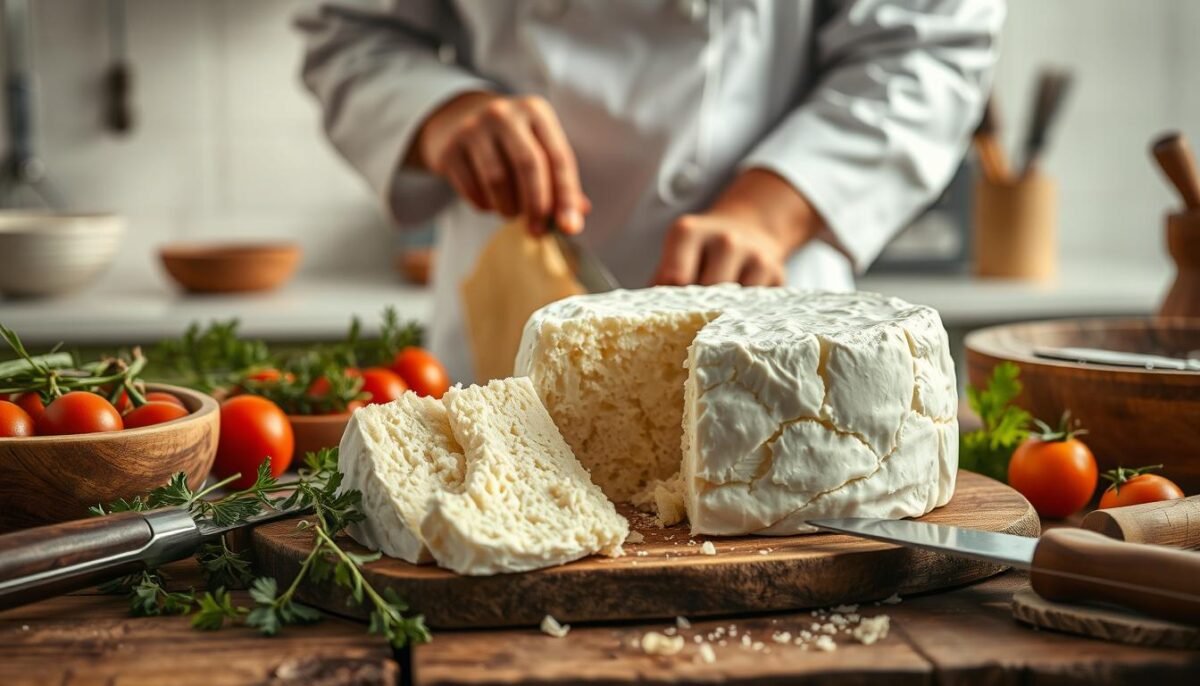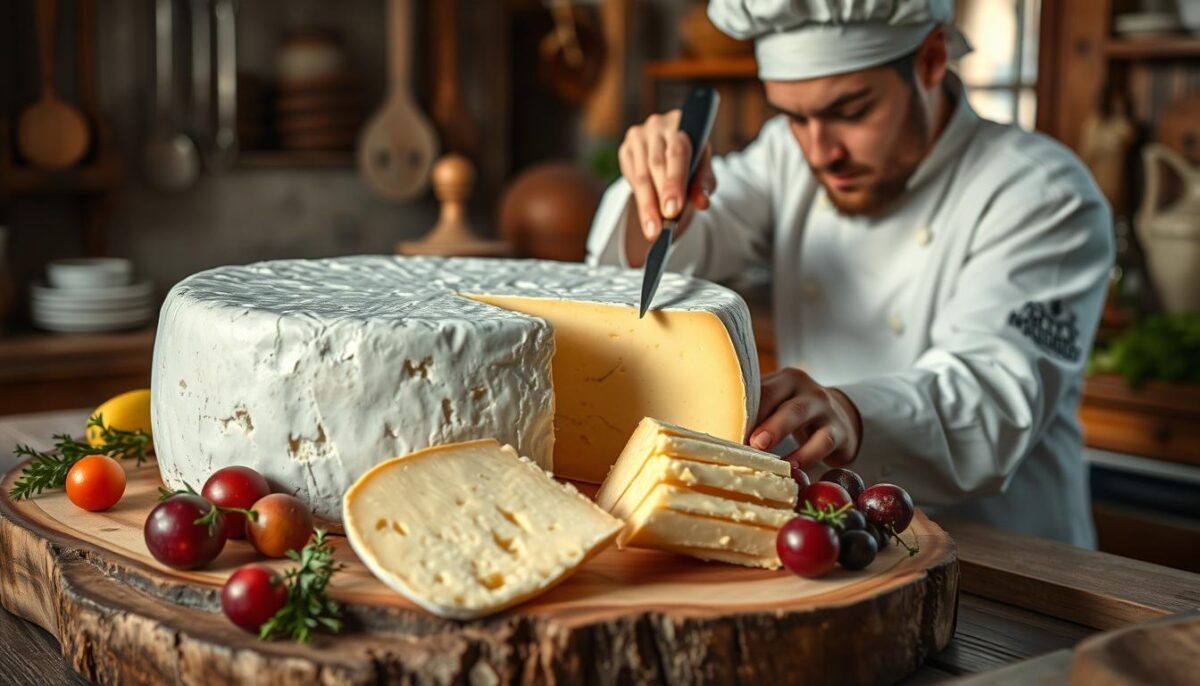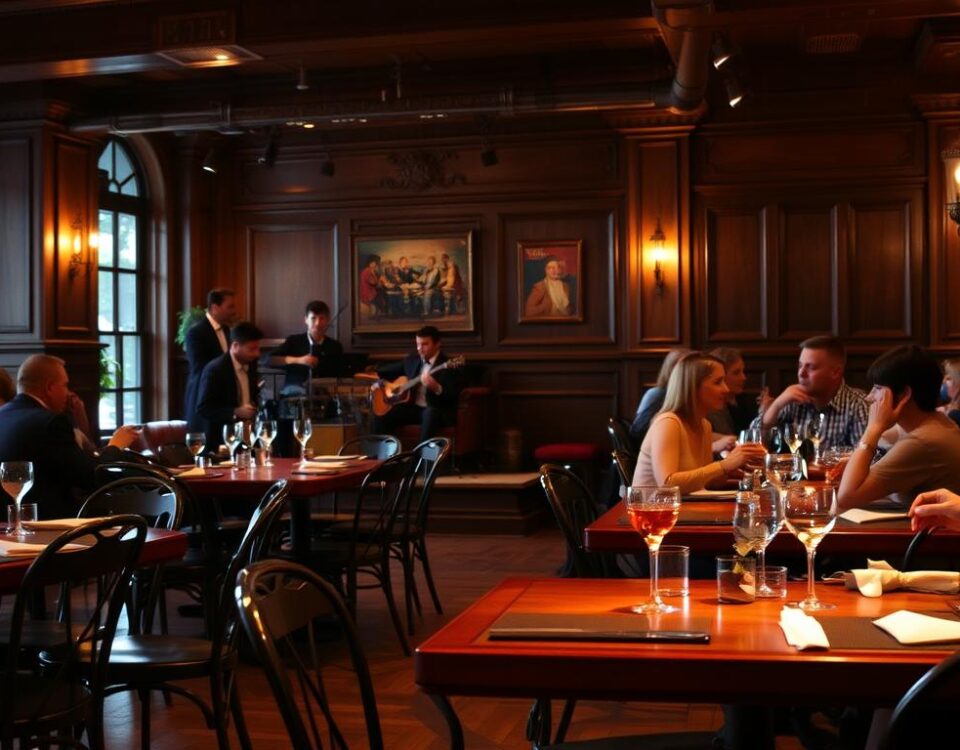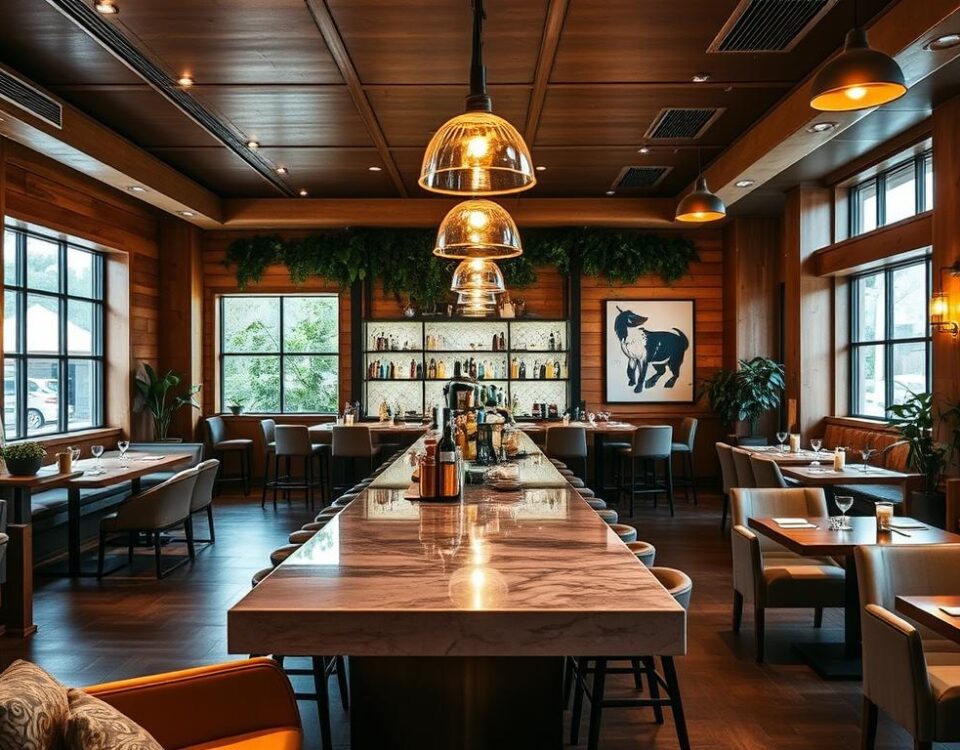
Cheeses for Melting: The Ultimate Guide
January 21, 2025
What Are the 5 Golden Rules for Roasting Vegetables to Perfection?
January 21, 2025Ever wonder why some cheeses cost as much as fine wines or jewels? The gourmet cheese world goes beyond taste. It’s where history, tradition, and rarity come together. Here, you find some of the most sought-after dairy delights.
Imagine you’re at a fancy gala. It’s black-tie, and the food is top-notch. Among the delicious offerings, a cheese platter stands out. Someone tells you, “This cheese is pricier than your best champagne.” This makes you wonder what makes these cheeses so unique. They’re valued for their scarcity, amazing production methods, and unique flavors.
Creating these luxury cheeses involves complex, time-consuming work. That’s why their prices can match those of precious metals. For example, making just one kilogram of Pule cheese requires 25 liters of donkey milk. This fact alone shows why these cheeses are so expensive.
Key Takeaways
- Expensive cheeses feature rare ingredients, boosting their value.
- These cheeses’ production can take years, making them more exclusive.
- Pule cheese, the priciest, needs 25 liters of donkey milk for a single kilogram.
- Some cheeses, like Moose cheese, are only made seasonally, limiting availability.
- These gourmet cheeses are more than food; they’re experiences showcasing rich history and careful creation.
Introduction to Expensive Cheeses
Diving into the world of premium cheeses opens our eyes to their high prices. We see artisanal cheeses made with great care. We also see ones made with rare ingredients. These aspects greatly impact their cost.
Why Are Some Cheeses So Pricey?
The cost of cheese depends on a few important factors. The rarity of the main ingredient, the complex cheese-making process, and how long it ages matter a lot. For instance, Pule cheese is super expensive, at about $500 per pound. Making it requires 25 liters of donkey milk for just one kilogram, which increases its price.
Factors Influencing Cheese Prices
Several reasons explain the price differences in artisanal cheeses:
- Type of Milk: Using rare milk, like from moose or Balkan donkeys, makes cheese more expensive. Moose cheese, for example, costs about $455 per pound. It’s rare and has few producers like the Johansson family in Sweden.
- Production Process: Complex and labor-heavy methods make cheese production costly. This affects its final price. For example, Wyke Farm Cheddar with white truffle and gold leaf is around $200 per pound. It needs special aging processes.
- Aging Period: How long and under what conditions the cheese ages also affects its price. Beaufort d’Éte ages in cool, moist conditions for at least 18 months. It sells for about 80 euros per kilogram.
Let’s look at some of the world’s priciest cheeses:
| Cheese | Price per pound | Unique Feature |
|---|---|---|
| Pule Cheese | $500 | Needs 25 liters of Balkan donkey milk for 1 kg |
| Moose Cheese | $455 | Made from three moose’s milk, only 240 kg made a year |
| White Stilton Gold | $450 | Has edible gold in it |
| Wyke Farm Cheddar | $200 | Mixed with white truffle and gold leaf |
| Bitto Storico | $150 | Aged for a whole ten years |
| Rogue River Blue | $40 | Aged at least one year |
| Caciocavallo Podolico | 85 euros per kg | Ages from three months to a year |
Getting to know the world of expensive cheeses helps us appreciate them more. It shows us the wide variety of artisanal cheeses out there. Each cheese is unique, showing its rich heritage and the effort put into making it.
1. Pule Cheese: The World’s Most Expensive
Pule Cheese is one of the world’s most expensive dairy products. It’s a favorite among cheese lovers. Made in Serbia, it’s a rare and luxurious find. It stands out for its unique taste and exclusive making process.
Production Process
Making Pule Cheese is all about love and skill. It’s made at the Zasavica Donkey Reserve. About 25 donkey mares are needed to make just one kilogram of cheese. A single donkey gives only 1.5 to 2 liters of milk a day. So, it takes a lot of time and effort to make this cheese.
The milk is high in protein and vitamins. It’s mixed with goat milk. Then, it ages for a month to reach perfection.

Taste Profile
Pule Cheese is famous for its special flavor and texture. It’s crumbly and has a rich, tangy taste. The donkey milk’s low fat and high Vitamin C make it special. It has a mix of sweet, sour, and umami flavors. This makes it unique in the luxury cheese world.
Availability and Rarity
Pule Cheese is very exclusive and rare. It costs €1 per gram. So, a kilogram can cost about €1,000. It’s made in a way that takes lots of time and has a small output. You can find it in select places. Mostly in Belgrade and some spots around the world.
This rarity and special making process explain its high price. It’s a true luxury.
2. Caciocavallo Podolico: A Culinary Gem
Caciocavallo Podolico is a standout among Italian cheeses. Its uniqueness and value make it a must-have in fine cheese collections. It’s made from the milk of the rare Podolica cattle in Italy’s south.
Historical Significance
This cheese’s history goes back many years. It is a big part of southern Italian culture. The cheese is made using old methods.
These include hanging it in pairs to age. This shows the local artisans’ commitment to keep their traditions alive. The Podolica cows’ rich milk makes this cheese even more special. It’s made with care, honoring old ways, making it a top pick among Italian cheeses.
Unique Flavor Characteristics
Caciocavallo Podolico’s taste sets it apart in high-end cheese circles. It has a rich, spicy, slightly sweet flavor. Its texture is smooth and firm.
The flavors come from Podolica cows eating wild herbs and brush. This gives the cheese complex and deep tastes.
The cheese is aged carefully, usually from March to May. This process gives it a unique taste. Priced around $50 per pound, enjoying this cheese means valuing Italy’s rich traditions and exquisite flavors.
3. La Madeleine: French Luxury
La Madeleine cheese is a symbol of French elegance and skill. It’s known for its rich tastes and traditional making ways. This cheese offers a luxury experience.

Production Techniques
Made using age-old methods, La Madeleine comes from generations of French cheesemakers. It starts with high-quality milk that’s creamy. This milk then gets warm and mixed with special cultures to start fermenting.
After fermentation, curds form and are cut and drained. This helps give La Madeleine its signature texture. They are then seasoned with fine salt to boost taste. The aging process is key, letting the cheese mature in controlled humidity. This develops its complex and subtly nutty flavor.
Pairing Suggestions
La Madeleine matches well with many foods and drinks. Pair it with light wines like Sauvignon Blanc or Chardonnay for a great taste mix. The wine’s acidity and the cheese’s creaminess balance each other out.
Fresh fruits like pears or apples offer a sweet crunch against the cheese. For more variety, add crusty breads or crackers. These pairings turn enjoying this cheese into a rich experience.
Eating La Madeleine by itself or in a cheese board is a treat. It shows the beauty of French cheese-making. The right combinations can highlight this cheese’s unique flavors, making it a top choice for cheese lovers.
4. Moose Cheese: An Unusual Delicacy
Moose Cheese is a unique treat from Sweden. It stands out not just because it’s rare, but also due to its impressive nutritional values. Let’s take a closer look at how Moose Cheese is made and discover its health benefits.
The Making Process
Creating Moose Cheese requires great care, as milking a moose isn’t easy. Each moose gives only a bit of milk daily. This process goes on from May to September. Due to these reasons, Moose Cheese is both rare and special.
The cheese ages for six months to a year. This long wait ensures it gets a deep and rich flavor. Its lengthy aging and the small amount produced make Moose Cheese one of the priciest cheeses, costing around 1000€ per kilogram.
Nutritional Value
Moose Cheese is not just rare; it’s also full of nutrients. It’s packed with protein, which is great for those needing more in their diet. Plus, it’s lower in fat than other luxury cheeses. This makes it a healthier choice.
For those who love unique Swedish cheeses, Moose Cheese is a perfect example. It showcases what can be achieved with hard work and skill. This cheese, made in small batches, highlights the exquisite craft of cheese-making around the world.
5. Bitto Storico: A Time-Honored Cheese
Explore the world of Bitto Storico, a celebrated aged cheese from Italy. Made in the peaceful Valtellina valley, it’s known for its evolving flavors over time. This cheese has delighted many with its taste.
Aging Process
Bitto Storico undergoes a careful aging process. It can age from 10 to 18 years, gaining incredible depth. Typically, it’s sold after aging 5 to 10 years.
About 10-20% goat milk is used in each wheel. This gives it a distinct taste. A 15-year-old Bitto Storico once sold for $6,400 in China, showing its high value.
Flavor and Aroma
Bitto Storico offers a wide range of flavors. Its long aging balances sharpness with nuttiness, beloved by Italian cheese fans. The aging also makes its aroma stronger.
Only 12 producers make Bitto Storico in Italy. Its unique taste and rarity make it one of the world’s top cheeses.
The Role of Geography in Cheese Prices
Geography greatly affects the prices of fine cheeses. From Italy’s Parmigiano-Reggiano to cheeses from Green County, Wisconsin, each region adds its touch. The environment shapes a cheese’s quality, taste, and cost.
Regions Known for Expensive Cheeses
Some areas are famous for their premium cheeses. Italy’s Emilia-Romagna, for example, is known for its Parmigiano-Reggiano. It follows strict rules to ensure its high quality. France’s terroirs produce unique cheeses like La Madeleine and Bleu de Bresse, known for their flavors.
In the US, Green County, Wisconsin stands out. Its dairy success comes from its complex soil and climate. This region, which shifted from lead mining to farming, is a leading cheese producer.
Local Ingredients and Their Impact
Local resources play a big role in cheese making. Parmigiano-Reggiano, with its specific local milk, offers a taste that can’t be found elsewhere. Meanwhile, in southwest England, the cheddar benefits from the lush pastures.
Green County has honed its cheesemaking for years. Swiss immigrants brought their methods, enhancing the local industry. The county’s unique terrain is ideal for dairy farming and cheesemaking.
The table below highlights notable cheese production regions and their renowned cheeses:
| Region | Renowned Cheese | Unique Attributes |
|---|---|---|
| Emilia-Romagna, Italy | Parmigiano-Reggiano | Protected designation, requires local forage |
| Southwest England | West Country Farmhouse Cheddar | Rich pastures, unique flavor profiles |
| Green County, Wisconsin | Various Artisanal Cheeses | Complex soil, immigrant heritage, artisanal practices |
| Normandy, France | Camembert | Local cow breeds, unique aging conditions |
| Loire Valley, France | Bleu de Bresse | Distinctive blue veining, local milk source |
Knowing how geography influences cheese highlights the unique flavors and textures. This makes luxury cheeses truly special.
How to Enjoy Expensive Cheeses
Enjoying expensive cheeses is about creating an experience that delights the senses. It involves gourmet serving suggestions and perfect cheese and wine pairing. Follow these practical cheese serving tips to elevate your cheese tastings.
Serving Suggestions
Serve premium cheeses at room temperature for the best flavor. Place them on a wooden board to highlight their quality. Include fresh fruits, nuts, and artisanal bread for a complete experience.
Pair soft and hard cheeses with the right foods. Soft cheeses like Brie go well with crusty baguettes. Hard cheeses like Parmigiano-Reggiano are amazing with honey or fig jam. This creates an incredible contrast.
Pairing with Wines and Other Foods
Choosing the right wine is crucial. It should enhance the cheese’s flavor without being too strong. Match wines and cheeses based on their richness. For example, a bold red wine is great with aged Cheddar. A creamy blue cheese pairs well with a sweet Sauternes.
Below are some specific pairings to try:
| Type of Cheese | Recommended Wine | Perfect Accompaniments |
|---|---|---|
| Brie | Chardonnay | Crusty baguettes, apples |
| Cheddar | Cabernet Sauvignon | Honey, grapes |
| Roquefort | Sauternes | Walnuts, pear slices |
| Manchego | Rioja | Almonds, quince paste |
With these cheese serving tips and gourmet serving suggestions, you’re ready for an amazing cheese night. The secret is in the preparation and enjoying every bite. Make every tasting a celebration of the cheese makers’ art.
Recipe Inspiration for Cheese Lovers
Do you love luxurious cheese dishes? Want to make your meals more exciting? There are many ways to enjoy cheese. Here are some ideas for tempting cheese recipes and gourmet cheese boards. They will wow any cheese lover.
Crafting Your Own Cheese Board
Making a gourmet cheese board is a creative process. It lets us mix different flavors and textures. Begin by choosing a mix of soft, hard, and blue cheeses. Try including some of the most luxurious cheeses. For example, Pule costs about $1,000 per kilogram. Moosbacher from Germany is around $137 per pound.
Add to your cheese board with fresh fruits, nuts, artisan bread, and fine charcuterie. A thoughtful presentation can turn a cheese board into the highlight of any event.
Unique Dishes Featuring Expensive Cheeses
Adding luxurious cheeses to unique dishes can make dining special. Here are some creative cheese recipes to experiment with:
- Keto Cauliflower Cheese – A low-carb dish that features rich cheeses for indulging tastes.
- Garlic Mushroom Macaroni Cheese – A smoky version of the classic mac and cheese.
- Twice Baked Cheese Soufflé – Light yet full of flavor, great for fancy dinners.
- Broccoli and Cheddar Soup – Cozy and perfect for any meal.
- Air Fryer Baked Eggs & Cheese – Quick and modern, made in an air fryer.
- Baileys Chococcino Cheesecake – Combines creamy cheese, chocolate, and Baileys for decadence.
These dishes show how versatile cheese can be. They can enhance brunch, mains, or desserts. Luxurious cheese can make any meal special.
Let these ideas inspire you to dive into the world of fancy cheeses. Create memorable meals right at home.
Conclusion: The Allure of Expensive Cheeses
Expensive cheeses draw people in with their top-notch quality, unique tastes, and careful making. They offer a chance to taste flavors that are hard to find anywhere else. Whether you know a lot about cheese or are just starting, spending more on quality cheese is often a good choice.
Why It’s Worth the Splurge
Cheeses like Pule, which can cost up to $1,300 per kilogram, show why they’re so prized. They need 25 liters of donkey milk to make one kilogram of cheese. This hard work and rarity result in a taste and texture that is unmatched. Cheeses like Cabrales and Époisses de Bourgogne are made with great skill.
Expensive cheeses do more than just taste good. They can make meals with wine and gourmet foods better. Matching hard cheeses with red wines, soft ones with white, and blue cheeses with sweet wines can make a meal special. Let these cheeses sit out for 30 minutes to 2 hours before eating to fully enjoy them.
Recommended Cheeses to Try
If you’re eager to explore gourmet cheeses, start with a variety. Try Caciocavallo Podolico, which costs between $50 to $150 per kilogram, for its deep flavor. La Madeleine from France offers a creamy texture, while Moose Cheese brings something new to the table.
Choosing these recommended cheeses means enjoying amazing tastes and supporting traditional cheese-making. Next time you think about buying expensive cheeses, remember their many benefits. From great taste to memorable meals, these cheeses are worth the investment. Give them a try and see how they change your food experiences.
FAQ
What are the 5 most expensive cheeses in the world?
The top five most costly cheeses are Pule Cheese, Caciocavallo Podolico, La Madeleine, Moose Cheese, and Bitto Storico. These cheeses stand out due to their unusual characteristics and how they are made. They also have high prices.
Why are some cheeses so pricey?
Cheese prices can hike for many reasons. The type of milk, how it’s made, and the aging time matter. Especially, cheeses from rare milk or those needing more work to make are pricier.
What factors influence cheese prices?
What makes cheese expensive includes the milk, how it’s made, its aging, and where it’s from. Premium cheeses need special skills to make and rare ingredients, which adds to their cost.
What is the production process of Pule Cheese?
Pule Cheese comes from Balkan donkeys in Serbia. Making it needs a lot of care, with 25 liters of milk for just one kilogram of cheese. Its scarcity and the hard work needed make Pule a very exclusive, expensive cheese.
What is the taste profile of Pule Cheese?
Pule Cheese is unique. It’s crumbly and has a rich, tangy taste. That special flavor is a big hit with food lovers.
What makes Pule Cheese so rare and expensive?
Pule Cheese’s rarity and price come from being only made in Serbia with a lot of milk needed for a bit of cheese. The tough process and scarcity make it a high-end cheese.
What is the historical significance of Caciocavallo Podolico?
Caciocavallo Podolico shows the rich history of cheese-making in southern Italy. It’s important because of its traditional making methods, kept alive by local makers for centuries.
What are the unique flavor characteristics of Caciocavallo Podolico?
Caciocavallo Podolico stands out with a rich, spicy taste and a bit of sweetness. Its firm, smooth texture enhances its special flavor, cherished in gourmet circles.
How is La Madeleine cheese produced?
La Madeleine is made with advanced French techniques. Its making process is meticulous, leading to a high-quality cheese that’s a treat to eat.
What are some pairing suggestions for La Madeleine cheese?
La Madeleine goes great with fresh, crisp wines and fruits. These pairings bring out the best in the cheese’s flavor, making for a great taste experience.
How is Moose Cheese made?
Moose Cheese, coming from Sweden, needs special conditions for the moose milking. Its unique making process limits how much can be made, making it a rare treat.
What are the nutritional benefits of Moose Cheese?
Moose Cheese is rich in protein and low in fat. Its nutritional benefits are a big plus for those looking to eat healthily.
What is the aging process of Bitto Storico?
Bitto Storico ages for a very long time, up to 18 years. This long aging brings out a deep, complex flavor and a strong smell. It’s a favorite among cheese lovers for its taste.
What are the flavor and aroma characteristics of Bitto Storico?
Bitto Storico has a deep taste and a strong smell from aging a long time. Its flavor is deep and complex, perfect for those who love intense, matured cheeses.
Which regions are known for producing expensive cheeses?
Places with a deep cheese-making history, like certain parts of Italy, France, and Sweden, make some of the most costly cheeses. They use local stuff and old ways to make cheese with unique traits and higher prices.
How do local ingredients impact the price of cheese?
The local environment, including soil, climate, and area, affects a cheese’s traits. Cheeses made with special local ingredients often cost more because of their distinctive taste and quality.
What are some serving suggestions for expensive cheeses?
For the best taste, serve expensive cheeses at room temperature. Make cheese boards look good and match the cheeses with wines and foods that highlight their rich flavors.
How should I pair wines with gourmet cheeses?
Choose wines that complement the cheese’s flavors without overwhelming them. Light, crisp wines are usually a good match for luxurious cheeses, making for an enjoyable taste experience.
What are some ideas for crafting a gourmet cheese board?
Make a fancy cheese board by choosing a variety of high-end cheeses. Mix different textures and tastes. Add fruits, nuts, and special bread to bring out the best in each cheese.
How can I incorporate expensive cheeses into unique dishes?
Use pricey cheeses as the main attraction in dishes. Pick recipes that showcase their unique tastes, like fancy mac and cheese, salads, or elegant cheese-based sauces.



